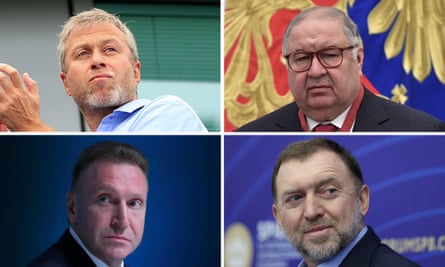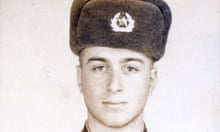More than $17bn (£13bn) of global assets – including offshore bank accounts, yachts, private jets and luxury properties in London, Tuscany and the French Riviera – have been linked to 35 oligarchs and Russian officials alleged to have close ties to Vladimir Putin.
Today, the Guardian, working in a partnership with the Organized Crime and Corruption Reporting Project and other international news organisations, is unveiling the initial research in an ongoing project to track the wealth of Russia’s most powerful operators.
The Russian asset tracker project will start by focusing on a list of 35 men and women named last year as Putin’s alleged enablers by the jailed opposition leader Alexei Navalny. It will record assets outside Russia where the reporting partners have seen evidence connecting them to these individuals.
Navalny’s organisation wrote to western governments requesting the names on its list be considered for sanctions and all but one have since been blacklisted by either the US, EU, UK or Canada.
The names include four of the wealthiest oligarchs, plus heads of state-controlled companies, prominent broadcasters, spy agency chiefs, ministers, political advisers and regional governors. They have been read out in the US Congress by lawmakers seeking tougher penalties for the Russian elite and in the UK parliament by the Liberal Democrat foreign affairs spokesperson, Layla Moran.
Moran told the Commons: “Putin’s cronies must be subject to the strongest possible sanctions now, because it is through them that Putin and his inner circle keep their wealth. If we go after his associates, we go after him. Actually, we are rather uniquely placed to do so, because they choose London. They live here: it is ‘Londongrad’ to them.”

The Russian asset tracker has identified UK properties or plots of land – collectively worth more than half a billion dollars – that are linked through companies, trusts or relatives to four leading figures on Navalny’s list: Roman Abramovich, Alisher Usmanov, Oleg Deripaska and Igor Shuvalov. The Guardian will report on these findings over the coming days.
The research so far has seen evidence, most of it dating from 2020 to the present, of the names being connected to more than 145 assets consisting of 35 mansions, 43 apartments and 27 other pieces of real estate. Seven yachts, plus 11 private jets and helicopters, worth a combined $2bn, have been identified as linked to just six individuals.
Some of the assets in the tracker are in the public domain – including Deripaska’s Belgrave Square mansion in central London, which was taken over by squatters last week, as well as the Dilbar, Lena and Amore Vero superyachts, linked to the oligarchs Usmanov, Gennady Timchenko and Igor Sechin respectively.

Other possessions have gone largely unnoticed, or sometimes existed in almost total secrecy. Last month, the US Treasury highlighted the problems of opaque ownership by stating: “Sanctioned oligarchs and powerful Russian elites have used family members to move assets and to conceal their immense wealth.”
Outside the UK, the Russian asset tracker has uncovered:
Twenty-six assets apparently connected to Deripaska, who is said to be Putin’s favourite industrialist. They include billions of dollars in shares, a hotel in the Austrian Alps, a superyacht, a 60-metre support vessel with helipad and luxury properties in London, Paris, Washington DC and New York, and four villas in Sardinia.
Two private jets – a $65m Gulfstream G650 and a Bombardier Global Express – connected to Shuvalov, Russia’s former first deputy prime minister and now chairman of the state development corporation. Shuvalov is also linked to three luxury properties collectively worth about $35m located in Salzkammergut, Austria, Tuscany in Italy, and Dubai, United Arab Emirates.
Property holding companies linked to the families of Nikolay Tokarev, the chairman of the state-controlled pipeline company Transneft, as well as the presidential press secretary, Dmitry Peskov. The Tokarev companies appear to own luxury properties on the Croatian island of Lošinj, a known hotspot for rich Russians, while the Peskov firm is connected to an expensive Paris apartment.

Many of the less well-known assets are held via shell companies based in offshore secrecy jurisdictions and trust funds, making them harder to track. Others are owned by relatives or associates of those on the Navalny list, raising questions about the source of funds used to acquire those assets.
They have been checked using proofs ranging from publicly available sources, data from the International Consortium of Investigative Journalists’ offshore leaks databases, the FinCEN files of reports of suspicious banking transactions and human intelligence sources.
The tracker serves as a snapshot in time, and includes assets only where reporters have seen documentary evidence or other reliable information linking them to the Navalny 35. Some possessions linked widely to certain oligarchs have yet to be confirmed.
Abramovich, Tokarev, Peskov and Shuvalov have yet to respond to requests for comment.
A spokesperson for Deripaska, said: “It is unclear how publishing this kind of ‘asset inventory’ might serve the public interest. Unless, of course, by ‘public interest’ you mean encouraging squatters to occupy private property, like they did with a London house belonging to Mr Deripaska’s relatives.
“All of the property and assets that he owns were acquired by fair means. The ongoing media frenzy, regrettable as it is, certainly doesn’t give anyone the right to call Mr Deripaska a kleptocrat. The Russia witch-hunt of which Mr Deripaska has become a victim is driven entirely by political motives.”
A spokesperson for Usmanov added: “The entirety of Mr Usmanov’s capital was built through successful, sometimes risky, investments, as well as through the effective management of his assets, which is the essence of business. Therefore, to characterise the source of his money as ‘non-transparent’ is inherently incorrect and damages Mr Usmanov’s reputation as an honest entrepreneur and philanthropist.”






